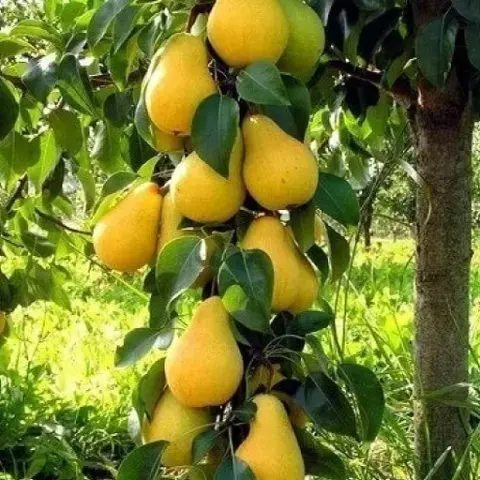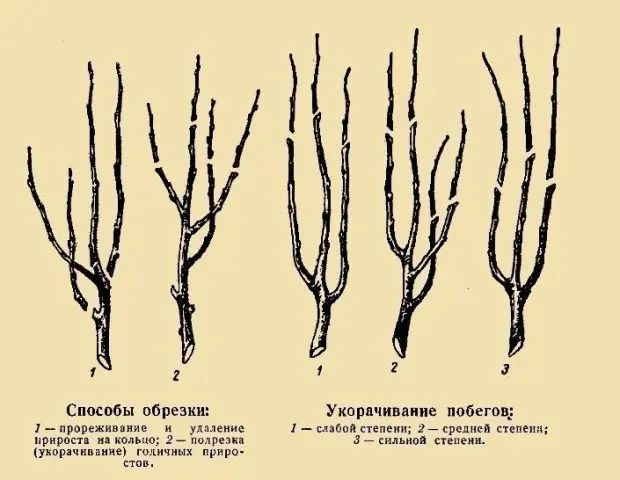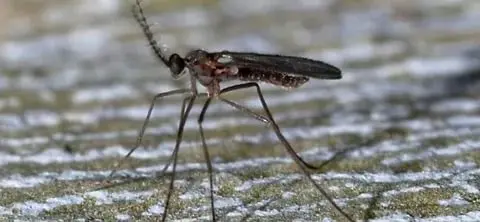Contents
Reviews about the decor’s columnar pear are only positive. The tree bears early, and due to its miniature size it can be grown in small gardens. The variety is unpretentious, but requires care.
Description of the variety of columnar pear Decora
The dwarf pear variety Decora was bred relatively recently, but has already gained popularity among gardeners. The tree is compact, rarely grows up to 2 m. The branches are small, pressed against the trunk, grow straight up. Coverage is good.
The columnar tree has good winter hardiness. With proper care, it can be grown in the Northern regions. Without additional shelter, the variety tolerates frosts down to -20 ° C.
Characteristics of fruits
The description of the Decora pear variety indicates that the fruits are large, which can be seen in the photo. The average weight reaches 200-250 g. The skin is colored evenly, without a blush. Pear color is yellow-green. The pulp is juicy, sweet, granular, aromatic.
The variety is classified as an autumn variety. Fruit ripening occurs at the end of August. Timing may vary in different regions.
Fresh harvest is stored well, but for this you need to create all the conditions. The fruits are suitable for all types of processing. They make compotes, jams or preserves. In addition, Decora pears are used for whole-fruit canning.
Pros and cons of the decor variety
If we talk about the merits of the variety, then we can distinguish:
- small tree size
- precociousness;
- stable yield;
- self-fertility;
- good plant immunity;
- ease of cultivation;
- large fruit size;
- good preservation of the crop;
- high life expectancy of a tree;
- acceptable frost resistance.
There are practically no shortcomings in the variety. However, it should be borne in mind that it is impossible to leave ripe pears on the branches for a long time. They fall off and deteriorate.

Optimal growing conditions
In order to harvest a good crop of Decora pear, the tree needs to create favorable conditions for fruiting. Seedlings are recommended to be placed in well-lit areas that are protected from cold winds.
The pear is unpretentious to the soil, but grows well on fertile soil. Chernozem, loam or sandy loam soil is suitable. The main condition is that groundwater should be low. The root system of the Decora pear does not tolerate wet areas, so drainage is necessary.
Planting and caring for Decora pear
Decora pear planting can be practiced in spring and autumn. The timing depends on the climate zone and personal preferences. In regions with a harsh climate, it is better to plant seedlings in the spring so that they have time to take root well and easily endure the winter. The optimal time is March-April. In milder climates, autumn pear planting is allowed, but work must be completed before the first frost. After October, planting is no longer necessary.
Rules of landing
For planting, it is better to use annual decora pear seedlings. They take root well, which cannot be said about adult plants. The seedling must be chosen correctly:
- Root system without damage and dry patches.
- Shoots are even, pressed to the trunk.
- Tree height up to 1 m.
If there are no one-year-old seedlings, then two-year-olds are quite suitable.
The pear is transported to the landing site so that the roots do not dry out. To do this, they are placed in a cloth bag and moistened well. Before planting, the seedling is additionally soaked in water for at least 8 hours.
A pit for planting Decora pear is prepared in advance, approximately 14 days in advance. During this time, the earth will settle and absorb all the fertilizers applied. The size of the pit is about 80-90 cm deep and 60 cm wide. On light soils, it can be deepened up to 1 m. The bottom is well drained. Next, fill the pit with humus and other organic fertilizers. You can make mineral complexes by mixing them with the ground.
Landing technique:
- Water the hole in advance so that the water is absorbed into the lower layers of the soil.
- Form a mound of their soil and lower the seedling.
- Spread the roots, raise the root collar at ground level and fill the voids with fertile soil.
- Water the seedling thoroughly.
The landing density cannot be reduced. Decor pear has an extensive root system. A distance of 1 to 2 m is maintained between seedlings. If there are a lot of trees, then row spacing is formed at 1,5 m.
Watering and top dressing
Immediately after planting, Decora pear needs abundant watering. Until the seedling takes root, it is watered 3-4 times a week, after which the soil is well mulched to retain moisture.
For abundant fruiting, Decora pear is useful to feed. But an excess of fertilizer is harmful to the tree, as is their lack. At the 2nd year of cultivation, they start feeding:
- In the spring, humus is introduced 1 time, the procedure is combined with loosening the soil.
- Further, they switch to mineral complexes, which include potassium and phosphorus.
- The main melting of top dressing is to alternate organic matter with mineral fertilizers.
- Apply humus no more than 1 time in 2-3 years.
Trimming

Columnar trees need to be pruned properly in order to ensure long-term fruiting and health of seedlings. Decora pear begins to form in the 2nd year of cultivation. The central trunk is shortened by 15 cm in spring to stimulate the growth of side shoots. In autumn, the longest of them are cut by a third.
Mature trees that have reached 7-8 years of age need to be rejuvenated. First, shoots are cut out at an acute angle to the trunk, after those that are parallel.
Whitewash
In spring and autumn, the trunk and skeletal branches of the decora pear must be whitened to prevent the spread of pests and diseases. Lime is diluted according to the instructions, copper sulfate is added for disinfection. The composition is applied with a brush, so that it fills all the cracks in the trunk well. The previously exfoliated bark is cleaned to a healthy tissue.
Preparation for winter
If a tree is grown in the Northern regions, then it must be covered for the winter. Preparations begin at the end of summer, when the trunks are whitewashed. With the onset of stable frosts, when the temperature drops to -10 ° C, they begin to warm the pear.
Instructions:
- Install a wooden frame around the tree, fix it with twine.
- Cover all free space with dry foliage or humus.
- The frame is additionally insulated with agrofiber or improvised material. Good to fix.
- After the snow falls, the tree is additionally covered.
- In the spring, the pear is gradually opened, without waiting for the thaw.
Pollination
The variety is self-fertile, but pollinators are needed for a stable large crop. For this purpose, pears are planted on the site:
- Chizhovskaya;
- In memory of Yakovlev;
- Lada.
You can use other trees whose flowering coincides with the Decora variety.
Productivity
The characteristics of the variety indicate that the decora columnar pear begins to bear fruit for 2-3 years of cultivation. Harvest every year, cyclicity is not observed.
From 1 adult tree, you can collect up to 20 kg of fruit, but for this you need to properly care for it. At 1 year after planting, seedlings may bloom, but experienced gardeners do not recommend leaving inflorescences. They need to be removed. The following year, only 6 fruits are left, the rest are removed so as not to overload the young plant. Further, the number of ovaries is regulated, looking at the health of the pear.
Diseases and pests

Decora’s columnar pear has good immunity, but a weakened tree can get sick. The most common pests and diseases of the variety:
- fruit gall midge;
- aphid;
- white scab.
The fruit gall midge lays eggs inside the inflorescences, the larvae eat away the ovary from the inside, the pears fall unripe. Up to 90% of the crop suffers from the pest. The fight against gall midge begins during the formation of buds. The tree is sprayed with Chlorophos and Metaphos preparations.
Green aphids suck out cell sap from young leaves and shoots, the plant slowly withers and dies. Pest control begins in early spring and continues throughout the season. The tree is sprayed with Karbofos. If there are few insects, then you can try folk remedies, for example, a solution of liquid soap.
Often a pear is affected by a fungus – white scab. It appears as yellow spots on the leaves of the tree. Gradually, the disease passes to the fruits, they become unfit for food. To prevent disease, Decora pear is sprayed with 3% Bordeaux liquid in early spring and after harvest. If the disease caught in the summer, then use a 1% solution so as not to burn the leaves.
Reviews about decor pear
Conclusion
Reviews of the decora columnar pear, apparently, only confirm the characteristics and description of the variety. The tree is really suitable for regions of risky farming, it needs normal care and preventive treatments. Before planting a variety on the site, you need to familiarize yourself with all its pluses and minuses.









